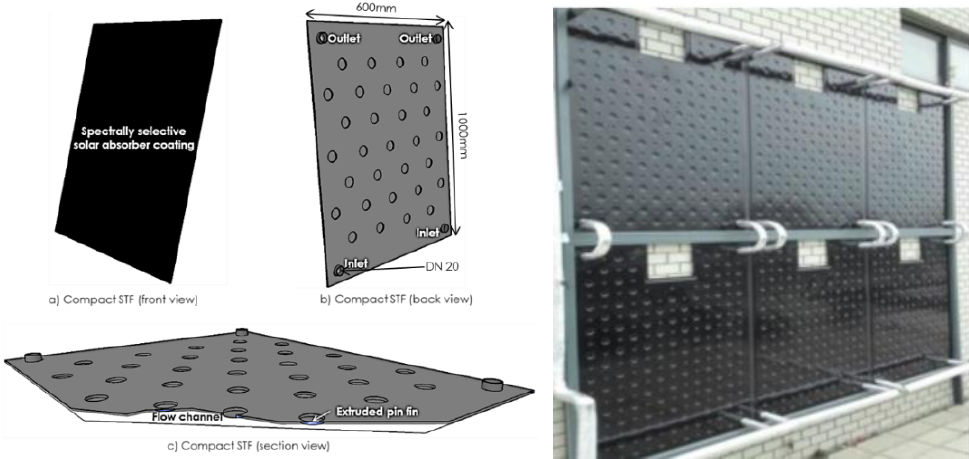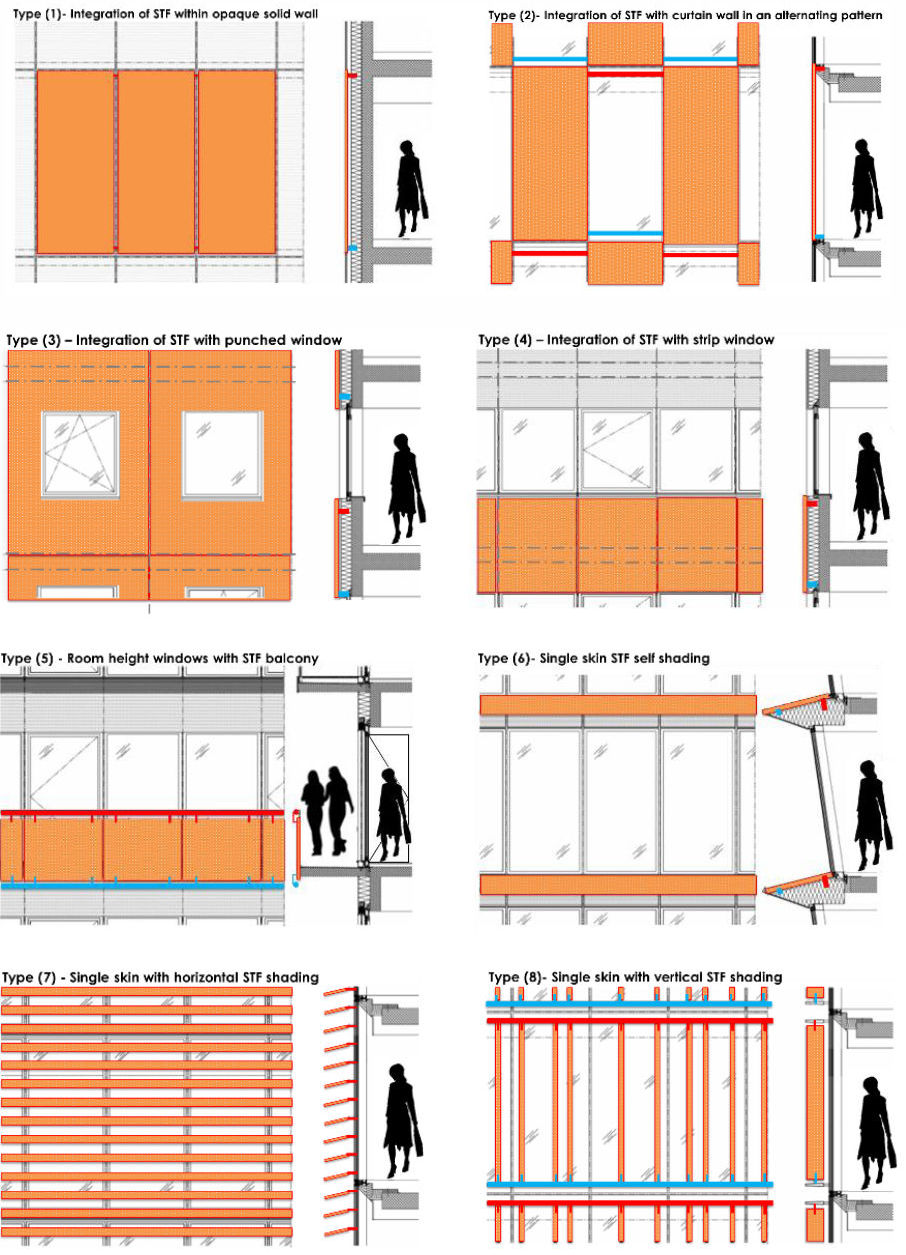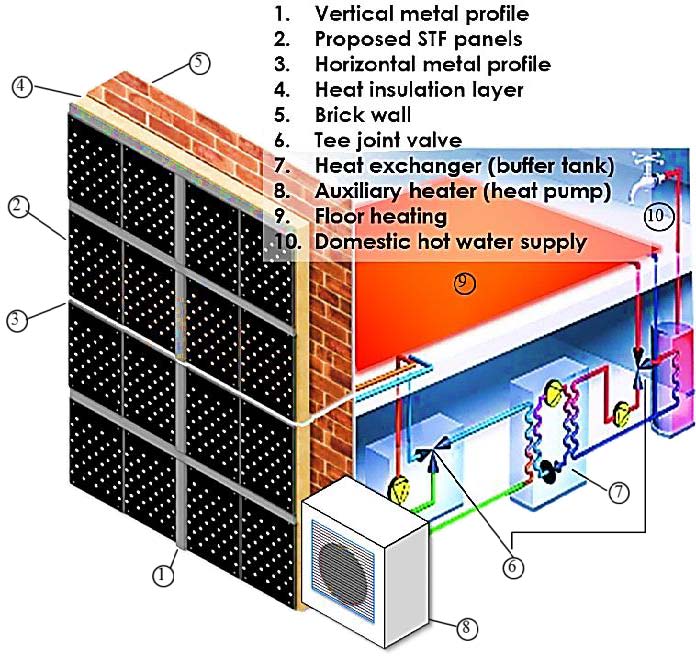Solar Energy Harvesting Systems
Prototype Systems
Compact Unglazed Solar Thermal Facade (STF) Module
By Jingchun Shen, Benedetta Copertaro and Xingxing Zhang, Dalarna University, Sweden
Product Description
Brief Concept Description
The “compact unglazed solar thermal façade module” is a multifunctional façade element that can harvest the impinging solar radiation to collect solar heat. The solution offers the advantages of a simple and low-cost structure, an aesthetically appealing appearance and an easy installation (plug & play). The absorber panel is composed of two welded stainless-steel sheets: the interior sheet shows an embossed surface with arrays of pin-fin corrugations, whereas the exterior sheet, which works as absorbing surface, remains smooth. The two metal sheets are joint along the perimeter, so to form a single unity with a built-in channel structure that is designed to minimize the use of pipes and guarantee a high flexibility in the customization of the panel (size and shape). The compact unglazed modules work on the same principle as conventional unglazed solar thermal collectors and can meet the demand of a range of applications such as pool heating, DHW preparation, and radiant space heating, with especially high performance in climates with warm ambient air temperatures and good solar irradiations. The combination with photovoltaic panels is also possible.

Figure 35. Schematic design of the compact STF panel with internally extruded pin-fin channels on the left and picture of a manufactured prototype flexible for integration with PV panels (back-view) on the right.
Architectural and Technological Integration into the Envelope
The simple design of the compact unglazed modules guarantees high flexibility in terms of architectural and technological integration in the facade, with some of the alternative designs including different metallic materials, colours, textures, shapes, sizes, installation methods, array connections and applications. Some examples of the wide range of integration possibilities are shown in Figure 36, where they are used as opaque wall elements, balcony claddings and as vertical/horizontal shadings.

Figure 36. Schematic designs of compact STF modules installations for mid/high-rise buildings (revised drawings based on pictures from Emmer Pfenninger Partner AG, 2012).
Integration into the Building: System and Comfort
The compact unglazed modules can be used in installations at different scales, from residential houses to large industrial or institutional buildings. Preferred applications are the ones with high DHW demand and/or comfort floor heating (hospitals, sport facilities, schools, multifamily buildings). Depending on the application, the modules can be connected to each other in different configurations (in parallel or in series) and arrangements (centralized and decentralized).
Figure 37 presents a typical concept design where the modules are installed in a multifamily household and used for domestic hot water preparation and space heating. The modules are connected in a decentralized arrangement in each dwelling, so that harvested solar heat is effectively delivered to the end users minimizing the distribution heat losses.
Overall, the design of the modules allows to achieve not only high thermal performance and a versatile architectural design, but also the possibility to create a scalable and modular system that is configured to meet the requirements of the single application.

Figure 37. Conceptual design showing the compact STF modules integrated in a façade.
SWOT Analysis
Strengths
- The architectural and technological integration is easy thanks to the wide range of installation options (window, balcony, overhang, roof and façade, with PV)
- Aesthetically versatile: the collectors resemble conventional metal walls and are available in various colours and shapes
- The collectors harvest solar heat with high thermal performance and lower dependence on weather conditions (such as dust, rain and snow) with respect to the conventional ones
- The investment cost is low with respect to traditional solar thermal collectors
- Easy handling during transport and installation is possible thanks to the low weight of the modules
- The collectors require low maintenance
Weaknesses
- Unglazed collectors are suited only for low temperature applications and require auxiliary or supplemental heating system
- A hot water tank or other thermal storage containers must be set up
- There are some risks due to the formation of mineral deposits, corrosion and leakage caused by freezing
- Heat dissipation is fundamental to prevent overheating in absence of heating demand
- Condensation may occur on the facade during the heating season
- High electricity consumption related to the circulation of the working medium
- Piping arrangement is critical in both building integration outlook and overall performance
Opportunity
- In some countries, the authorities include solar heating systems in their incentive programs
- Since some well-established large-scale industrial processes for metal sheets working are used, it is expected that significant cost reductions and various architectural and aesthetic requirements can be achieved with the increased flexibility in industrial mass production
- The movement toward ”sustainable buildings”, “green buildings” and even “zero energy buildings” is a strong driver for the adoption of solutions of this kind
Threats
- Proper design, commission and HVAC integration are needed to achieve good performances
- The apparent simplicity of the solutions might lead to a naive and inexperienced competition
- Different legislative constraints in each country can be an obstacle
- Architects and building designers are sceptical about relevant building integration solutions other than the established system application
Lessons Learned
- Building integrated solar façades must be aesthetically appealing and technically reliable to be accepted by architects and stakeholders.
- Building Information Modelling design is suggested to estimate the potential impact of the building integration considering the whole process. The associated features offer the valuable possibility for design professionals to assess multiple design alternatives against different priorities and resources (such as time, energy, budget), thus helping in the decision-making process towards a collaborative sustainable design.
- It is necessary to have specific guidelines or standards to address the integration constrains with regard to hygiene/ hydraulic/construction aspects.
- Hygrothermal analysis should be carried out to investigate the risk of moisture transfer in the exterior façade, especially for installations in households.
Further Reading
J. Shen et al. (2018) A multifunctional facade with solar thermal technology: Investigation of a compact unglazed solar thermal facade for building integration, Lap Lambert Academic Publishing 2018, ISBN: 978-613-3-99092-0
X. Zhang, J. Shen et al. (2016) An initial concept design of an innovative flat-plate Solar Thermal Facade for building integration (Chapter 14), Sustainable Buildings and Structures; Page: 103-107; 2016 Taylor & Francis Group, London, ISBN: 978-1-138-02898-2
J. Shen, X. Zhang et al. (2016) Characteristic study of a novel compact Solar Thermal Facade (STF) with internally extruded pin–fin flow channel for building integration, Applied Energy 2016; 168: 48-64.